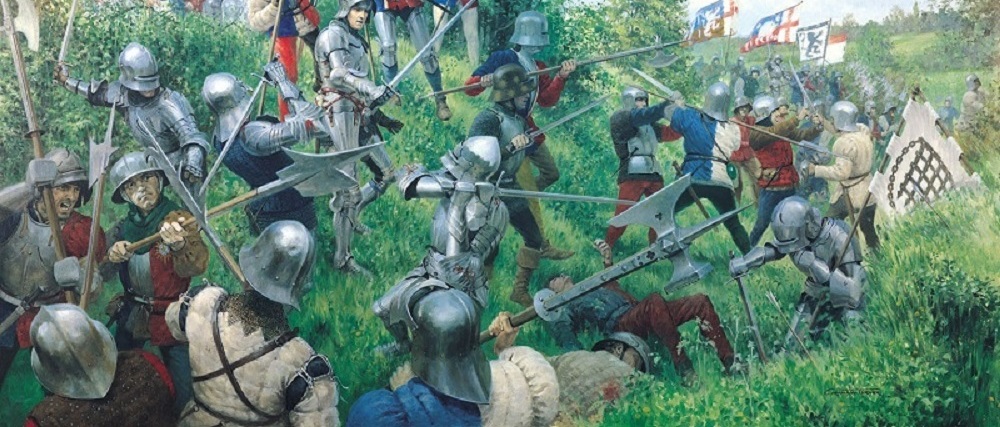Battle of Tewkesbury
Posted on 10th January 2021
Following their defeat at the Battle of Barnet, Lancastrian forces needed to swell their numbers, so Edmund Beaufort, Duke of Somerset travelled towards Wales to gain the support of Jasper Tudor.
On the same day, Lancastrian forces were beaten at the Battle of Barnet, Margaret of Anjou and her son Edward, Prince of Wales landed in England from France. The ground was now set for the next battle in the Wars of the Roses.
Edward IV learnt of Margaret’s arrival within days. He raised an army at Windsor and set out for the West Country.
The Lancastrian army with Margaret headed towards the city of Gloucester, as this was the closest point to cross the River Severn into Wales.
To thwart their advance, Edward sent messages to Sir Richard Beauchamp in Gloucester, ordering him to bar the gates of the city to Margaret and her army, forcing her to march a further 10 miles (16 km) to Tewkesbury to find another crossing into Wales. At Tewkesbury, they rested for the night.
Edward marched his army 31 miles (50 km) to Cheltenham and when discovering Margaret’s and Somerset’s position he marched them a further 6 miles (9.7 km), stopping 3 miles (4.8 km) from the Lancastrian force.
At dawn on 4 May 1471 the Lancastrian army took up a strong defensive position one mile south of the town of Tewkesbury, south of Tewkesbury Abbey on pastureland.
Their army was ordered into three sections. The right command was held by Edmund Beaufort, Duke of Somerset although the area was hard to traverse as it had a stream running through it. The centre was led by Lord Wenlock with assistance from Edward, Prince of Wales and the left was led by the Earl of Devon.
The Yorkists were outnumbered but they still split their army into three sections. The vanguard was led by Richard, Duke of Gloucester, the rear commanded by Lord Hastings and the main army commanded by Edward with support from the Duke of Clarence.
Edward IVs position was close to a wooded area, and seeing the possible danger to his left flank, he despatched a small force of spearmen to occupy the woods to prevent Lancastrian forces using them.
Edward moved his Yorkist forces forward, through ground broken up by woods and ditches which made it difficult to attack in any order, however they used their artillery to bombard the Lancastrians with arrows and shot.
The Duke of Somerset led part of his men to attack Edwards left flank, but Edward fought them back. The soldiers hidden in the woods attacked Somerset from his right flank with help from Gloucester’s army.
Somersets surviving army tried to escape across the River Severn, but most were cut down as they fled. Lord Wenlock had not supported Somerset, and Somerset demanded to know why. Before Wenlock could even answer Somerset killed him.
The rest of the Lancastrian army fled, but many drowned trying to cross the river and others were caught by their pursuers.
Edward, Prince of Wales was executed at only eighteen years of age, by Clarences men, and his father Henry VI was later executed with Queen Margaret imprisoned. The Duke of Somerset was also executed.
This decisive Yorkist victory led to Edward IV ruling for a further twelve years, but following his death in 1483, the Lancastrian force would rise again.
Battle of Tewkesbury
Fought - 4 May 1471
Location - Tewkesbury, Gloucestershire
Participants - House of York and House of Lancaster
Army
York 3,500 - 5,000
Lancaster 6,000
Leaders (York)
Edward IV
Richard, Duke of Gloucester
William, Lord Hastings
Leaders (Lancaster)
Edmund Beaufort, Duke of Somerset
John Beaufort, Marquess of Dorset
John Courtenay, Earl of Devon
John, Lord Wenlock
Margaret of Anjou
Edward, Prince of Wales
Victory - House of York
Casualties
2,000
John Beaufort, Marquess of Dorset (Lancaster)
John Courtenay, Earl of Devon (Lancaster)
Edward, Prince of Wales (Lancaster)
Tagged as: Junior Middle Ages
Share this post:





